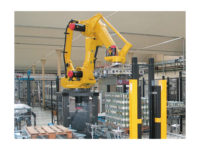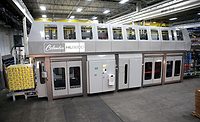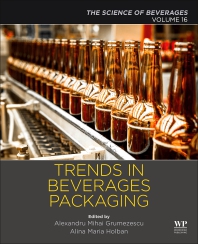In a famous episode of the “I Love Lucy” show, Lucy and Ethel go to work in a candy factory where their packaging skills are put to the test. Chocolates make their way one by one down a conveyor, and the women must wrap each one before it reaches the next packaging station. If one chocolate makes it past them unwrapped, they’ll be fired.
At first, they’re able to keep up with demand, but it’s not long before the speed of the conveyor belt exceeds the women’s packaging speed. Thus, they begin hastily eating the unwrapped chocolates and hiding them in their shirts and hats so that their boss believes they’ve done their job. Although this scene is hilarious for the viewing public, it might strike a chord with many warehouse employees who struggle with meeting a similar excessive demand.
On the beverage line, if automation isn’t incorporated throughout the process, bottlenecks can develop. However, in this case, the problem can’t be solved by consuming or hiding the product.
Instead, many beverage-makers and distributors are turning to automated palletizing and depalletizing equipment to keep production running efficiently. However, a growing variety of packaging types is threatening to throw a wrench in the process.
Flexibility is key
In recent years, beverage-makers have looked to packaging to differentiate their products. This has resulted in custom bottle shapes and sizes, which stand out on retail shelves but often can slow down the production and distribution processes.
“Processors are developing innovative containers and packaging to differentiate their products and grow their market share,” says Bryan Sinicrope, vice president of sales and marketing for A-B-C Packaging Machine Corp., Tarpon Springs, Fla. “We see this across the beverage market.”
As a result, the flexibility to efficiently handle so much packaging variety is the most important attribute of palletizing and depalletizing equipment, he says.
In fact, operative flexibility is the key to facing demand for a wide variety of sizes and types of packages in the growing beverage industry, says Matteo Tagliaferri, marketing and communication at Sipa SpA, Vittorio, Veneto, Italy.
“With this perspective, robot applications have the maximum flexibility, the possibility to cope with different lines, and, considering also the possible future, the convertibility to react against some changes of the market strategies,” he notes.
Recently, Sipa equipped its Genius family of palletizers and depalletizers with Fastlayer technology, which is comprised of one or two anthropomorphic robots that orient and arrange the packages to prepare the layer, Tagliaferri explains. This system can be integrated upstream from any type of palletizer with fixed or mobile pallets, he adds.
To boost the flexibility of the system, Sipa increased the motorizations managed by the inverters for a quicker changeover, he explains. Plus, there is no need to manually adjust the gripping head during the changeover; all motions are automatically managed by pre-set features on the operator panel, reducing the number of errors and saving time, he adds.
The system also can manage different package sizes without having to replace mechanical parts, he notes.
In addition to flexibility and reduced changeover time, this hybrid approach increases performance within a small footprint and ensures delicate handling to prevent product damage. It can assemble as many as 700 layers an hour, Tagliaferri says.
“This application is perfectly suited to the needs and trends of the beverage market, which demands increasingly light bottles and supports increasingly demanding marketing in terms of product differentiation,” he says.
In the future, flexibility will continue to play a significant role, Tagliaferri adds.
“When choosing a new machine, it is very difficult to know which kind of product you will be required to handle in the future,” he explains. “[A] high flexibility level will help reduce the costs of future changes that will certainly happen during the lifecycle of the equipment.”
In a white paper released in March, Grand Rapids, Mich.-based System Logistics Corp. also highlights the need for flexible systems in the food and beverage space. Among the solutions to address the increasing number of different package sizes and mixed pallet requests, the company offers its Best Fit software for palletizing operations.
“At the center of the Best Fit is a powerful 3-D viewer, providing users with the ability to view each pallet assembled using solids or wireframe,” the white paper says. “This view allows users to gain access to order information, status, exceptions and configuration parameters used in the robotic assembly of the pallet.”
Earl Wohlrab, palletizing and robotic integration systems manager for Mason, Ohio-based Intelligrated, agrees that systems should be designed to be “as flexible as possible with respect to packaging trends.” Flexibility is one of the main considerations that beverage-makers should think about before bringing automation into their warehouse, he says.
To accommodate a facility’s needs now and in the future, A-B-C Packaging offers a range of palletizing and depalletizing systems with built-in flexibility.
“We build depalletizers that can adapt to different bottle and container sizes with no-change parts and quick changeover,” Sinicrope says. “This gives beverage processors maximum flexibility for production today and versatility for future requirements. Palletizers are also made for maximum flexibility, and we offer modular designs to help packagers customize their machine.” However, as beverage packages get more and more diverse, packaging material trends change as well. For instance, premium glass packaging has increased in the wine and distilled spirits market, according to A-B-C Packaging’s Sinicrope. Furthermore, secondary packaging is being eliminated in some cases, Intelligrated’s Wohlrab adds. As a result, the need for gentle handling of packaging has impacted palletizing and depalletizing systems.
As mentioned earlier, Sipa’s Genius palletizers with Fastlayer robotics offer gentle handling to accommodate an increase in lightweight bottles. Likewise, Intelligrated’s Alvey 950 hybrid palletizer features one or more robotic arms for gentle, high-speed, in-line palletizing.
Mixing it up
In recent years, retailers have begun requesting more “just-in-time” deliveries of product instead of storing stock in their own warehouses. This has caused a shift among manufacturers and distributors to deliver smaller amounts of product more frequently. Add the proliferation of SKUs to the mix, and it’s clear why the conventional palletizing and depalletizing model of forming one-SKU layers and full pallets is losing ground when it comes to order fulfillment. Today, beverage-makers and distributors are moving to individual case handling, explains Sean O’Farrell, market development director for Dematic Corp., Grand Rapids, Mich.
In response to these trends, Dematic recently introduced its RapidPall palletizing system.
“The RapidPall is designed to handle many different case and tote sizes for building mixed-case order pallets, display pallets and roll containers in a store-friendly, aisle-ready product delivery,” O’Farrell says.
Showcasing its flexibility, the system can palletize as many as 10,000 different SKUs in a warehouse, he notes.
The RapidPall combines with a conveyor, depalletizer and the Dematic Multishuttle buffering/staging/sorting/sequence buffer modules to make up the company’s new AMCAP automated mixed-case palletizing solution. The AMCAP system made its debut in North America last month. It was designed to be flexible, scalable and modular for companies that want to test a level of automation that they would not have considered in the past, O’Farrell explains.
“We are starting to see consolidation in the beverage industry, which will see more SKUs and different types of products being distributed beyond the traditional beverage warehouse,” he says. “That is why Dematic developed the AMCAP solution to be as flexible as possible for order fulfillment operations.”
Investing in automation
Industry trends are pointing to the need for warehouse automation, but the start-up costs of automating a facility can seem daunting. Dematic’s O’Farrell points out that even though the initial cost might be high, there are many factors that justify the purchase.
Initially, adding automatic palletizers and depalletizers to a warehouse can save on labor and handling. However, beverage-makers should look at the big picture to understand how valuable automation can be, he says.
“Beverage manufacturers should look beyond the initial savings in labor and handling,” O’Farrell explains. “Automation is becoming easier to justify when looking at the big picture of reduced product damage, increased product quality, increased order accuracy, ability to reduce days-on-hand of inventory, increased ergonomics, ability to become nimble and the main justification of greater customer satisfaction.”
In fact, the ability to build a store-friendly, aisle-ready pallet in a tall, dense way can save as much as 10 percent on transportation costs, delivering a return on investment of between three and five years, he says.
Dematic’s O’Farrell has high expectations for automation in the future, saying: “In the next seven to 10 years, I can see highly automated mixing centers being built on the outskirts of large urban centers that will take beverage products, food and non-food items and automatically store, pick, palletize (or put into totes/cartons), stretch wrap and label the outbound order in a practically lights-out operation. Many benefits can be realized from greening of the supply chain, reducing the amount of trucks on the road, to optimizing store replenishment and reducing the amount of inventory in the supply chain.”








